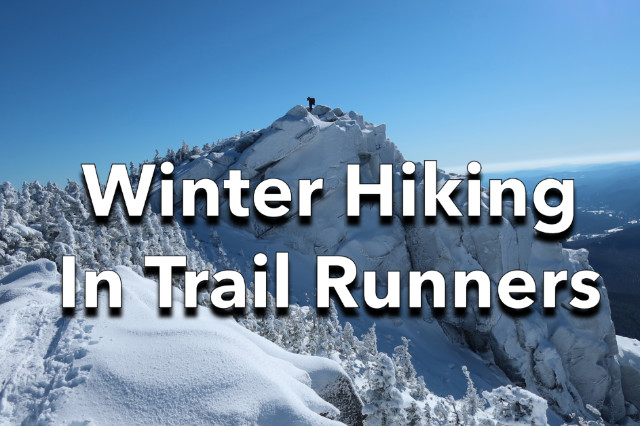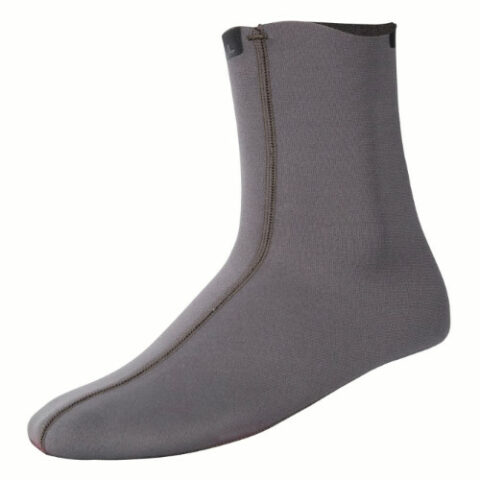
If you use trail runners for hiking and backpacking in three-season weather, it is possible to keep using them in winter instead of insulated winter hiking boots or mountaineering boots. There are some advantages to doing this. Trail runners are substantially lighter weight than boots, so you can hike farther and faster with less fatigue, and they usually cause fewer hiking blisters than boots, if you’re prone to that kind of thing.
But when it comes to winter footwear, your shoes, be they boots or trail runners, are just one component of an integrated winter footwear system that needs to address four key requirements:
- insulation
- waterproofing
- traction
- flotation
Granted, it is easier to build a winter footwear system around insulated waterproof boots because that is the status quo. But there are ways to assemble a functionally equivalent system around trail runners if you’re willing to do a lot of experimentation and you’re reasonably conservative in your testing of its limitations. Failure is not an option when it comes to cold injuries caused by inadequately insulated or waterproof winter footwear.
Below, I enumerate some of the options available to you if you want to build a cold-weather footwear system around trail runners, including some observations about how they perform in different winter conditions.
Insulation
There are a couple of ways to add insulation to a trail runner. Many people wear Neoprene socks or waterproof socks inside their trail runners to insulate their feet and provide some moisture protection. These are available in different thicknesses and heights and you’ll want to experiment with a few different ones to figure out what works for different temperatures. You may also have to adjust your shoe size to accommodate an insulated sock.

Check out the Neoprene and waterproof sock selection from NRS, Showers Pass, and Sealskinz. You can also just wear plastic bags over thick woolen socks. The plastic will keep your feet warmer because it prevents evaporative cooling, a process that pulls body heat away from your skin.
Another approach is to wear a Neoprene overboot, like the Forty Below Light Energy Tr Shorty Overboot which is worn over a trail runner and has a foam insole for added insulation. I’ve used these for winter hiking and they’re easy to use with microspikes, crampons, and snowshoes. Unfortunately, they’re hard to get this year because there’s a worldwide shortage of Neoprene.

Waterproofing
You want to avoid getting water into trail runners in winter because it will freeze inside your shoes. The easiest way to keep them dry is to get a waterproof/breathable trail runner lined with Gore-Tex, eVent, or some other proprietary membrane. The waterproof/breathable liner will create a cushion of warm air around your feet, but I wouldn’t put much stock in their breathability: what you care about is their waterproofness.
You also need to prevent snow from entering the top of your shoes from above and wetting your socks, especially if you’re hiking on trails that have not been broken out (packed down) by other hikers. Gaiters are the obvious solution, but there are also winterized trail runners that have built-in gaiters to prevent snow from entering above. Some of these have deep lugs and tungsten spikes for traction, which is an interesting combination used by winter trail runners on packed trails.

I once used a pair of La Sportiva Crossover GTX Trail Runners (no longer made) with a built-in gaiter and it was quite effective. The La Sportiva Blizzard GTX Trail Runner, available today, has one, as do the Salomon Snowspike Climasalomon Waterproof Trail Runners.
Traction Aids
When hiking on packed trails, you’ll want a lightweight traction aid like microspikes to prevent slips and to help grip the walking surface. For thicker and moderate-angle ice, you’ll want a more aggressive crampon with longer spikes, but one that’s designed for use with very soft-soled shoes.
Lightweight Traction Aids
Unfortunately, Kahtoola Microspikes and Hillsound Trail Crampon Ultras can be uncomfortable when worn with trail runners. Both have free-floating metal spikes attached by chains to a stretchy elastomer harness. But the harness squeezes the toebox and can cause blisters, while you can feel the spikes through the soft soles of trail runners.
One alternative is to add hobnails or screws to the soles of your trail runners so the screw heads act like tire studs. The two winter trail runners mentioned above, the La Sportiva Blizzard GTX and the Salomon Snowspike Climasalomon Waterproof also come with factory-installed spikes, which is great, as long as you remember to take them off before you walk across wood floors (they can also shred snowshoe decking). The Blizzard has 7mm lugs, so it really wears like a studded snow tire!

There are also all various traction aids that are designed for use with soft-soled trail runners, like Kahtoola Nanospikes, Kahtoola EXOSpikes, Hillsound Flexstep Crampons, Black Diamond’s Blitz Spike Traction Device, the Black Diamond Distance Spike Traction Device, Vargo Pocket Cleats, and numerous others. These provide more flexibility because they’re easily removed when they’re not needed or when you need to switch to a more aggressive crampon, or snowshoe, below. The key variables to consider when evaluating these light traction devices are comfort, specifically in the toe box and from below through the sole, and spike length, since this determines how much traction they provide.
Crampons for Trail Runners
When choosing crampons for trail runners, you want a pair that are compatible with very soft-soled shoes. These are not rigid climbing crampons, but ones designed for hiking on flat terrain and moderate inclines when a longer, sharper spike is required.
The key feature to look for is a very bendy flex bar (also called a leaf spring) connecting the front crampon to the heel crampon. The bindings should also be compatible with a soft heel and lower profile toe box. The best ones I’ve found for soft-soled trail runners are Kahtoola’s K-10 crampons which have a binding system that is tailor-made for a low-toe box and heel counter. Most of the other crampons out there have bindings designed for use with soft-soled boots instead.

When you order the K-10’s, they come with “snow release skins” (often called anti-balling plates) that you’ll want to attach to the crampons. These keep wet snow from clumping to the bottom of the crampons, making it impossible to walk.
Flotation
Snowshoes are designed for flotation, to let you hike on the surface of the snow without sinking into it. But one of the challenges of outfitting yourself for winter hiking is that you often don’t know what the snow depth on your route is unless you hike on heavily used trails that are broken out by other hikers. If that’s the case, you can usually forgo snowshoes completely and just hike with light traction.

If there’s a light coating of packed snow, you can often get away with a very lightweight racing snowshoe, like the Atlas Run Snowshoe (2 lbs 5 oz/pr) or Dion Snowshoes 121 Quick Fit (2 lbs 4.9 oz/pr). But if there’s substantially more snow, you’ll want a snowshoe that has more surface area and provides more flotation. For flat and rolling terrain, Northern Lites Elite Snowshoes (2 lbs 5 oz/pr) are a good lightweight option. If you hike in steeper mountainous terrain, you’ll want snowshoes with large crampons and a televator bar (for climbing hills) like the Atlas Helium Trail Snowshoes (3 lbs 2 oz/pr), which is one of the lightest snowshoes available for that kind of terrain (there’s a new model out that has an improved binding.)
As it stands, trail runners are compatible with just about every snowshoe binding made today, so you shouldn’t have any problems finding snowshoes that fit into a trail runner-based winter footwear system. But it will also take some experimentation to find the lightest weight snowshoe you need for your local conditions.
Wrap Up
If you’re interested in building a winter footwear system around trail runners, it can be done. However, it will probably take a lot of trial-and-error experimentation to put together a complete system that suits your needs. I’d focus first on finding a waterproof trail runner, insulated sock, gaiter, and traction combination that works for winter hiking before you try to spend a lot of time optimizing snowshoe weight.
See also:
SectionHiker is reader-supported. We independently research, test, and rate the best products. We only make money if you purchase a product through our affiliate links. Help us continue to test and write unsponsored and independent gear reviews, beginner FAQs, and free hiking guides.
